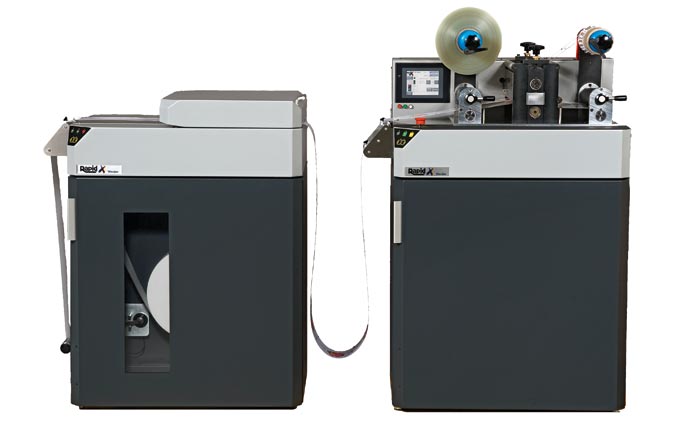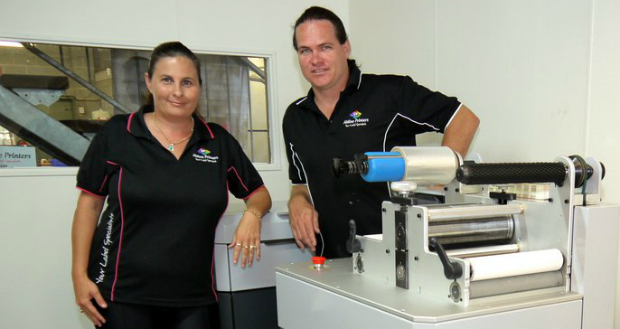
What does it do?
It is a semi-rotary diecutter that uses conventional flexible dies. It has just one cylinder so users don’t need a huge cylinder library to operate it for variable size labels. It is designed as a single stage machine, there is no unwind or rewind. Matrix stripping and laminating are standard features. It has a throughput of 5-18 metres per minute.
Rapid Machinery’s Nick Mansell says the machine is designed for very fast set-ups and avoids the “significant waste” that is created by many of the other machines on the market.
“A lot of the machines out there for volume digital converting still have hangovers from traditional label manufacturing. They are long machines with a lot of web in the machine, and
a lot of the processes are reasonably time consuming or consume a lot of materials to set up.”
Mansell says this ultra-quick makeready ethos is influenced by Rapid Machinery’s partnership with Memjet. Rapid manufactures a number of small footprint digital presses using Memjet Waterfall printheads.
“You can print one or two labels and the first or second label is going to be saleable,” says Mansell. Wasting saleable goods in make the diecutter ready would be senseless.
It is not uncommon for a semi-rotary diecutter to have 15-20 metres of web in the machine, says Mansell. “If you can’t access the first print in your converting machine there is no point in having the first print good off your digital machine.”
The D2 takes a fraction of that, from 30cm up to about half a metre to set up.
When was it launched?
Rapid showed a concept prototype at LabelExpo last year in Brussels and launched the product at Label Forum Japan in Tokyo in July. Rapid has already made headway into the Japanese market, appointing a master distributor there.
Who is it be aimed at?
The D2 is aimed squarely small converters in the super short-run market of sub-5,000 labels. The machine runs inline with Rapid’s Memjet-powered presses and can be supplied as an all-in-one label converting line. However, Mansell has broader hopes for the diecutter, which can also run inline or near-line off the back of leading digital presses, including market leader HP Indigo.
How does it compare to its other machines?
This is Rapid’s first semi-rotary diecutting machine. However, the firm has built “many” full rotary diecutting machines, says Mansell, as well as several semi-rotary applications and upgrades. Rapid had worked closely with Danish manufacturer Etipol on semi rotary letterpress machines for a number of years.
What are its unique selling points?
Mansell lists four main selling points of the D2: low capital cost, small footprint, efficient set-ups and ease of use. “It is deigned to be operated by people brand new to label printing and converting.”
How does it differ from rival products?
Mansell says the D2 fits in an unfilled niche between higher-end diecutters and trailing knife-type machines, which are more suited to jobs measured in the hundreds, not thousands.
He says the kinds of diecutting machines that can keep up with the speeds of modern digital presses are extremely expensive – “around $200,000 for high-speed laser diecutting”. On the lower end, he claims that the throughout of stylus-type machines is so low that a converter would need a number of machines to satisfy the throughput from one of Rapid’s Memjet presses.
How much does it cost?
A standalone D2 diecutter starts at $38,000 for the base specification. Rapid is also marketing an integrated line that comprises the Rapid X2 digital printer and the D2 with a rewinder for US$70,000 (pictured above).
Mansell says prospective customers should focus on total cost of ownership, explaining that not only is the D2 competitively priced, it also offers major savings on set-up waste – particularly relevant for some of the more expensive digital label stocks. “We’ve seen one
stock that is $12 a square metre,” he adds.
The fact the D2 takes just one cylinder promises further cost savings, as opposed to machines that require a range of magnetic cylinders, which can cost $1,500-$2,000 each, says Mansell.
How easy is it to use?
Simplicity is one of the machine’s biggest selling points, he says. For most applications, he expect a customer would be up and running in less than a day. When he trained the team in Japan, they learned how to run on the floor at Label Forum and were running it in less than an hour, even though it isn’t yet programmed with Japanese language.
What service and support is on offer?
“We are the manufacturer so we can support our products very well within Australia,” says Mansell.
He says Rapid designs machine to be user serviceable to a great extent. He says of the “$40 million to $50 million” of Rapid machinery around the world, the entire global billings for sales and service per year adds up to around $30,000 to $40,000.
SPECS
Speed 5-18 metres per minute
Web width 50-254mm
Diecutter Semi-rotary magnetic cylinder
Price $38,000
Contact 0413 233 244 rapidmachinery.com
Comment below to have your say on this story.
If you have a news story or tip-off, get in touch at editorial@sprinter.com.au.
Sign up to the Sprinter newsletter

